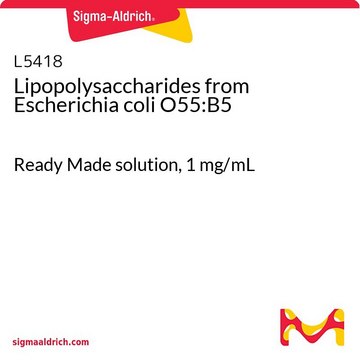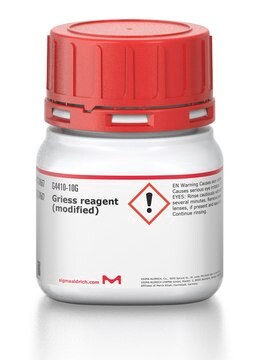L5293
Lipopolysaccharides from Escherichia coli O111:B4
Ready Made solution, 1 mg/mL
Synonim(y):
LPS
About This Item
Polecane produkty
pochodzenie biologiczne
Escherichia coli (O111:B4)
Poziom jakości
Postać
aqueous solution
stężenie
1 mg/mL
kolor
colorless to faint yellow
rozpuszczalność
water: soluble
Warunki transportu
wet ice
temp. przechowywania
2-8°C
Szukasz podobnych produktów? Odwiedź Przewodnik dotyczący porównywania produktów
Zastosowanie
- to stimulate an inflammatory response in porcine liver tissues in-vivo and piglet ileum tissues ex vivo
- to stimulate Ex vivo natural killer(NK) cells and hepatic B cells
- to induce arthritis in a standard rabbit model
Działania biochem./fizjol.
Uwaga dotycząca przygotowania
Inne uwagi
produkt powiązany
Kod klasy składowania
12 - Non Combustible Liquids
Klasa zagrożenia wodnego (WGK)
WGK 1
Temperatura zapłonu (°F)
Not applicable
Temperatura zapłonu (°C)
Not applicable
Środki ochrony indywidualnej
Eyeshields, Gloves, multi-purpose combination respirator cartridge (US)
Certyfikaty analizy (CoA)
Poszukaj Certyfikaty analizy (CoA), wpisując numer partii/serii produktów. Numery serii i partii można znaleźć na etykiecie produktu po słowach „seria” lub „partia”.
Masz już ten produkt?
Dokumenty związane z niedawno zakupionymi produktami zostały zamieszczone w Bibliotece dokumentów.
Klienci oglądali również te produkty
Produkty
Poznaj strukturę, funkcję i różnorodne zastosowania lipopolisacharydów. Odkryj ich rolę w bakteriach, specyficzność serologiczną i potencjał badawczy.
Powiązane treści
Lipopolisacharyd (LPS) jest głównym składnikiem bakterii Gram-ujemnych, ważnym dla badań mikrobiologicznych.
Nasz zespół naukowców ma doświadczenie we wszystkich obszarach badań, w tym w naukach przyrodniczych, materiałoznawstwie, syntezie chemicznej, chromatografii, analityce i wielu innych dziedzinach.
Skontaktuj się z zespołem ds. pomocy technicznej




